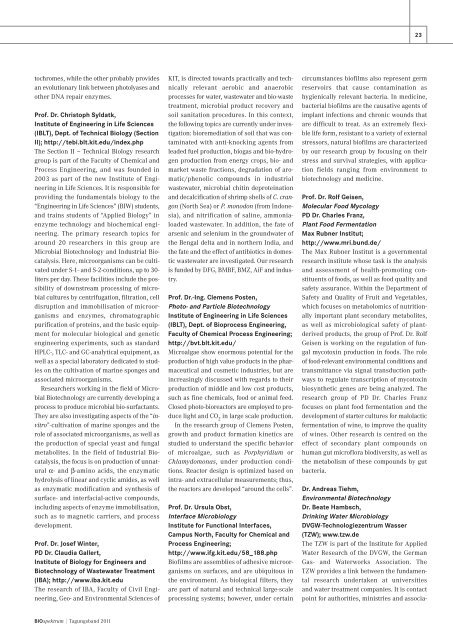VAAM-Jahrestagung 2011 Karlsruhe, 3.â6. April 2011
VAAM-Jahrestagung 2011 Karlsruhe, 3.â6. April 2011
VAAM-Jahrestagung 2011 Karlsruhe, 3.â6. April 2011
You also want an ePaper? Increase the reach of your titles
YUMPU automatically turns print PDFs into web optimized ePapers that Google loves.
23tochromes, while the other probably providesan evolutionary link between photolyases andother DNA repair enzymes.Prof. Dr. Christoph Syldatk,Institute of Engineering in Life Sciences(IBLT), Dept. of Technical Biology (SectionII); http://tebi.blt.kit.edu/index.phpThe Section II – Technical Biology researchgroup is part of the Faculty of Chemical andProcess Engineering, and was founded in2003 as part of the new Institute of Engineeringin Life Sciences. It is responsible forproviding the fundamentals biology to the“Engineering in Life Sciences” (BIW) students,and trains students of “Applied Biology” inenzyme technology and biochemical engineering.The primary research topics foraround 20 researchers in this group areMicrobial Biotechnology and Industrial Biocatalysis.Here, microorganisms can be cultivatedunder S-1- and S-2-conditions, up to 30-liters per day. These facilities include the possibilityof downstream processing of microbialcultures by centrifugation, filtration, celldisruption and immobilisation of microorganismsand enzymes, chromatographicpurification of proteins, and the basic equipmentfor molecular biological and geneticengineering experiments, such as standardHPLC-, TLC- and GC-analytical equipment, aswell as a special laboratory dedicated to studieson the cultivation of marine sponges andassociated microorganisms.Researchers working in the field of MicrobialBiotechnology are currently developing aprocess to produce microbial bio-surfactants.They are also investigating aspects of the “invitro”-cultivationof marine sponges and therole of associated microorganisms, as well asthe production of special yeast and fungalmetabolites. In the field of Industrial Biocatalysis,the focus is on production of unnaturalα- and β-amino acids, the enzymatichydrolysis of linear and cyclic amides, as wellas enzymatic modification and synthesis ofsurface- and interfacial-active compounds,including aspects of enzyme immobilisation,such as to magnetic carriers, and processdevelopment.Prof. Dr. Josef Winter,PD Dr. Claudia Gallert,Institute of Biology for Engineers andBiotechnology of Wastewater Treatment(IBA); http://www.iba.kit.eduThe research of IBA, Faculty of Civil Engineering,Geo- and Environmental Sciences ofKIT, is directed towards practically and technicallyrelevant aerobic and anaerobicprocesses for water, wastewater and bio-wastetreatment, microbial product recovery andsoil sanitation procedures. In this context,the following topics are currently under investigation:bioremediation of soil that was contaminatedwith anti-knocking agents fromleaded fuel production, biogas and bio-hydrogenproduction from energy crops, bio- andmarket waste fractions, degradation of aromatic/phenoliccompounds in industrialwastewater, microbial chitin deproteinationand decalcification of shrimp shells of C. crangon(North Sea) or P. monodon (from Indonesia),and nitrification of saline, ammonialoadedwastewater. In addition, the fate ofarsenic and selenium in the groundwater ofthe Bengal delta and in northern India, andthe fate and the effect of antibiotics in domesticwastewater are investigated. Our researchis funded by DFG, BMBF, BMZ, AiF and industry.Prof. Dr.-Ing. Clemens Posten,Photo- and Particle BiotechnologyInstitute of Engineering in Life Sciences(IBLT), Dept. of Bioprocess Engineering,Faculty of Chemical Process Engineering;http://bvt.blt.kit.edu/Microalgae show enormous potential for theproduction of high value products in the pharmaceuticaland cosmetic industries, but areincreasingly discussed with regards to theirproduction of middle and low cost products,such as fine chemicals, food or animal feed.Closed photo-bioreactors are employed to producelight and CO 2in large scale production.In the research group of Clemens Posten,growth and product formation kinetics arestudied to understand the specific behaviorof microalgae, such as Porphyridium orChlamydomonas, under production conditions.Reactor design is optimized based onintra- and extracellular measurements; thus,the reactors are developed “around the cells”.Prof. Dr. Ursula Obst,Interface MicrobiologyInstitute for Functional Interfaces,Campus North, Faculty for Chemical andProcess Engineering;http://www.ifg.kit.edu/58_188.phpBiofilms are assemblies of adhesive microorganismson surfaces, and are ubiquitous inthe environment. As biological filters, theyare part of natural and technical large-scaleprocessing systems; however, under certaincircumstances biofilms also represent germreservoirs that cause contamination ashygienically relevant bacteria. In medicine,bacterial biofilms are the causative agents ofimplant infections and chronic wounds thatare difficult to treat. As an extremely flexiblelife form, resistant to a variety of externalstressors, natural biofilms are characterizedby our research group by focusing on theirstress and survival strategies, with applicationfields ranging from environment tobiotechnology and medicine.Prof. Dr. Rolf Geisen,Molecular Food MycologyPD Dr. Charles Franz,Plant Food FermentationMax Rubner Institut;http://www.mri.bund.de/The Max Rubner Institut is a governmentalresearch institute whose task is the analysisand assessment of health-promoting constituentsof foods, as well as food quality andsafety assurance. Within the Department ofSafety and Quality of Fruit and Vegetables,which focuses on metabolomics of nutritionallyimportant plant secondary metabolites,as well as microbiological safety of plantderivedproducts, the group of Prof. Dr. RolfGeisen is working on the regulation of fungalmycotoxin production in foods. The roleof food-relevant environmental conditions andtransmittance via signal transduction pathwaysto regulate transcription of mycotoxinbiosynthetic genes are being analyzed. Theresearch group of PD Dr. Charles Franzfocuses on plant food fermentation and thedevelopment of starter cultures for malolacticfermentation of wine, to improve the qualityof wines. Other research is centred on theeffect of secondary plant compounds onhuman gut microflora biodiversity, as well asthe metabolism of these compounds by gutbacteria.Dr. Andreas Tiehm,Environmental BiotechnologyDr. Beate Hambsch,Drinking Water MicrobiologyDVGW-Technologiezentrum Wasser(TZW); www.tzw.deThe TZW is part of the Institute for AppliedWater Research of the DVGW, the GermanGas- and Waterworks Association. TheTZW provides a link between the fundamentalresearch undertaken at universitiesand water treatment companies. It is contactpoint for authorities, ministries and associa-BIOspektrum | Tagungsband <strong>2011</strong>





